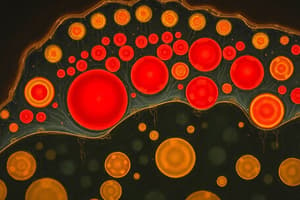Podcast
Questions and Answers
How many cells are estimated to occupy the diameter of the field of view?
How many cells are estimated to occupy the diameter of the field of view?
Approximately six cells.
What fraction of the field of view will one cell occupy?
What fraction of the field of view will one cell occupy?
1/6 of the field of view.
How is the diameter of the field of view calculated in relation to the cells?
How is the diameter of the field of view calculated in relation to the cells?
It is calculated as 1/6 times the diameter of the field of view.
In the drawing, what is the recorded height of the giraffe's head from the ground?
In the drawing, what is the recorded height of the giraffe's head from the ground?
What significant information is provided regarding the giraffe in the diagram?
What significant information is provided regarding the giraffe in the diagram?
Why is it important to know the diameter of the field of view?
Why is it important to know the diameter of the field of view?
What does the fraction 1/6 represent in this context?
What does the fraction 1/6 represent in this context?
What dimension is used to measure the giraffe in the drawing?
What dimension is used to measure the giraffe in the drawing?
How does magnification affect the size representation of objects in drawings?
How does magnification affect the size representation of objects in drawings?
What main aspect of the giraffe is highlighted in the context of the field of view?
What main aspect of the giraffe is highlighted in the context of the field of view?
Flashcards are hidden until you start studying
Study Notes
Introduction to Biology
- Biology is the scientific study of living organisms.
- The term 'Biology' derives from Greek words: 'Bios' meaning life and 'Logos' meaning knowledge.
Main Branches of Biology
- Botany: Focuses on the study of plants.
- Zoology: Concerns the study of animals.
Other Branches of Biology
- Ecology: Examines the relationship of living things with their environment.
- Genetics: Investigates inheritance and genetic variation in organisms.
- Biochemistry: Studies the chemical processes and substances in living organisms.
- Microbiology: Involves the study of microorganisms.
- Cell Biology: Examines the structure and function of cells.
Characteristics of Living Things
- Living organisms respond to environmental changes (e.g., temperature, humidity).
- Movement: Shift in position or progress in location (e.g., swimming, walking in animals; closing leaves in plants).
- Metabolism: All chemical reactions occurring within living organisms.
Cytoplasm
- Acts as a fluid medium for chemical reactions within cells.
- Involves cytoplasmic streaming for material movement.
- Contains organelles like starch, glycogen, fat droplets, and dissolved substances.
Nucleus
- Surrounded by a double membrane known as the nuclear membrane.
- Allows selective passage of materials in and out of the cell.
- Animal cells have small vacuoles; plant cells contain larger vacuoles storing sugars, salts, and food.
Cell Wall
- A rigid outer covering of plant cells, primarily composed of cellulose.
- Provides shape, mechanical support, and protection to plant cells.
- Facilitates the passage of water, gases, and other materials.
Visual Representation of Cells
- A diagram of a field of view illustrates cell size—approximately six cells occupy the field.
- One cell occupies about 1/6 of the field of view diameter.
Example: Giraffe Measurement
- In a drawing of a giraffe, the top of the head is recorded at a height of 10 cm from the ground, showcasing additional measurement and orientation skills in biology.
Studying That Suits You
Use AI to generate personalized quizzes and flashcards to suit your learning preferences.




